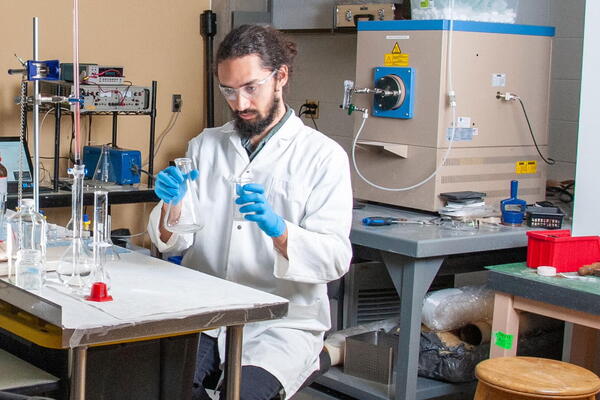
How to suspend one liquid inside another
Waterloo-led research team creates “programmable” droplets with potential usage in wastewater treatment and carbon capture

Waterloo-led research team creates “programmable” droplets with potential usage in wastewater treatment and carbon capture
By Media RelationsResearchers led by a team at the University of Waterloo have developed a way to create tiny droplets of one liquid inside another liquid without mixing the two together.
Known as droplet templating, the technique enables the creation of a new class of nanoparticle-based soft materials with potential applications in carbon capture and wastewater treatment.
The process involves assembling and jamming nanoparticles onto the surface of an aqueous-based droplet, forming a strong outer shell that keeps each droplet intact and distinct. These coated droplets can then be filled with a wide range of nanoparticles and dried to form lightweight, porous aerogel beads.

The aerogel bead droplets are filled with magnetic particles that can be used to shield against electromagnetic waves. A magnet under the Petri dish helps to attract the droplets into the 'C' position. (University of Waterloo)
“This technique allows researchers to create hybrid aerogels by filling each droplet or bead with specific nanomaterials for different targeted uses,” said Dr. Milad Kamkar, a professor in Waterloo’s Department of Chemical Engineering.
“Researchers can now control not only the composition but also where each droplet is arranged within a liquid, essentially making the droplets and the resulting soft materials and aerogels programmable.”
Kamkar added that the droplet templating process could have a significant impact on wastewater treatment. The aerogel beads could be loaded with different nanoparticles, each targeting specific contaminants, and strategically packed in a column to optimize treatment as wastewater flows through it.
In the fight against climate change, aerogel beads could be infused with metal-organic frameworks and other functional materials to capture carbon dioxide from the air. Potential applications also include sensors, electronics and the aerospace industry.
“This technique allows researchers to create layered, gradient or mixed aerogels, opening up new possibilities for designing multifunctional materials,” said Kamkar, who is also director of the Multiscale Materials Design Lab. “Scientists can now control the precise location of components and nanomaterials.”
 Another potential use case for droplet templating is to shield against electromagnetic waves, which can interfere with sensitive equipment. Aerogel beads filled with magnetic and conductive nanomaterials could be strategically placed in buildings like hospitals to protect patients and equipment from electromagnetic interference.
Another potential use case for droplet templating is to shield against electromagnetic waves, which can interfere with sensitive equipment. Aerogel beads filled with magnetic and conductive nanomaterials could be strategically placed in buildings like hospitals to protect patients and equipment from electromagnetic interference.
“In the modern world, we’re constantly surrounded by electromagnetic waves from electronics such as cell phones, laptops and Wi-Fi, which can negatively affect the performance of sensitive equipment,” Kamkar said.
“These waves can also cause serious health issues, such as cancer. Removing this invisible pollution from our environment is a big challenge, and these aerogel beads could help address it.”
Kamkar and the Waterloo team collaborated on this research with researchers at the University of British Columbia and Drexel University in Philadelphia.
A paper on their work, Droplet-templating soft materials into structured bead-based aerogels with compartmentalized or welded configurations, recently appeared in Material Horizons.
Second image: A suspended droplet atop a generated interfacial layer of nanoparticle (CNC)-surfactant. The top phase is hexane-POSS, and the bottom phase is CNC suspension. (University of Waterloo)
Feature image: Dr. Milad Kamkar, a professor in Waterloo’s Department of Chemical Engineering, photographed in his laboratory where he developed the droplet technology that can contain one liquid inside another. (University of Waterloo)

Read more
The Governor General Gold Medal awards graduate students for their remarkable academic achievements and transformative research

Read more
Six Waterloo graduates share their stories of perseverance, innovation and advocacy as they prepare to cross the stage at convocation

Read more
Waterloo alum Keith Cleland is changing the way industrial and commercial properties store energy sustainably with his startup's saltwater batteries
The University of Waterloo acknowledges that much of our work takes place on the traditional territory of the Neutral, Anishinaabeg, and Haudenosaunee peoples. Our main campus is situated on the Haldimand Tract, the land granted to the Six Nations that includes six miles on each side of the Grand River. Our active work toward reconciliation takes place across our campuses through research, learning, teaching, and community building, and is co-ordinated within the Office of Indigenous Relations.